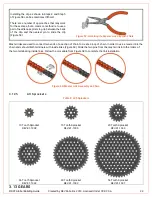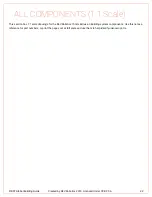
FIRST Global Building Guide Created by REV Robotics 2019, Licensed Under CC BY-SA
31
3.12
SPROCKETS AND CHAIN
REV Robotics sprockets are a #25 pitch and are made from molded acetal (Delrin/POM). Sprockets are designed to fit a
5mm hex shaft, which eliminates the need for special hubs and setscrews. The REV Robotics building system is designed
around slotted extrusion which allows components attached to the extrusion to slide to any desired location for tension
adjustment. There are six different sprocket sizes available with a maximum reduction of 5.4 (Table 9).
Sprockets are used with chain to transmit torque from one axle to another. By selecting sprockets larger or smaller
relative to the input sprocket, we can either increase the output speed or increase the output torque as shown in Figure
53. However, the total power in the system is not effected.
When a larger sprocket drives a smaller one, for one rotation of the larger sprocket the smaller sprocket must complete
more revolutions so the output will be faster than the input. If we reverse the situation and a smaller sprocket drives a
larger output sprocket, then for one rotation of the input the output will complete less than one revolution resulting in a
speed decrease from the input. The ratio of the sizes of the two sprockets is proportional to the speed and torque
changes between them.
Figure 53: Using Sprockets to Increase Speed or Torque
From Figure 53 we know that the ratio in size from the input (driving) sprocket to the output (driven) sprocket determines
if the output is faster (less torque) or has more torque (slower). To calculate exactly how the sprocket size ratio effects
the relationship from input to output we can use the ratio of the number of teeth between the two sprockets.
Sprocket and chain is a very efficient way to transmit torque over long distances. Modest reductions can be
accomplished using sprockets and chain, but gears typically provide a more space efficient solution for higher ratio
reductions.















































